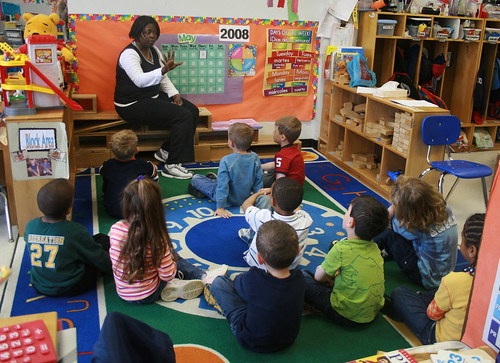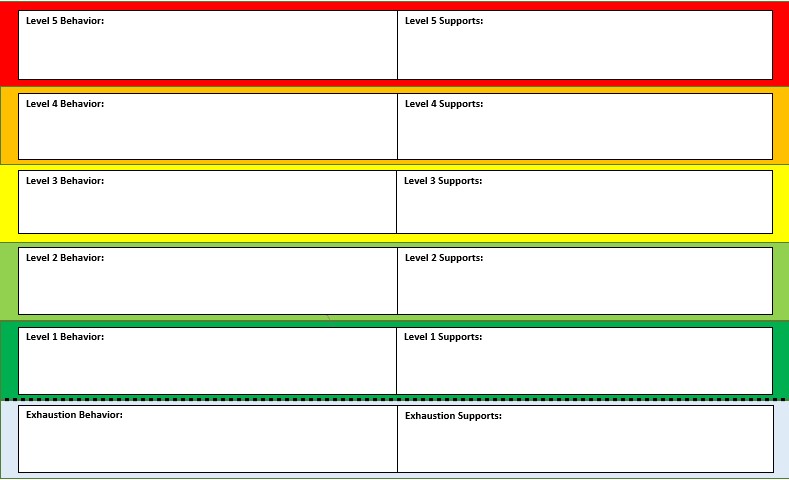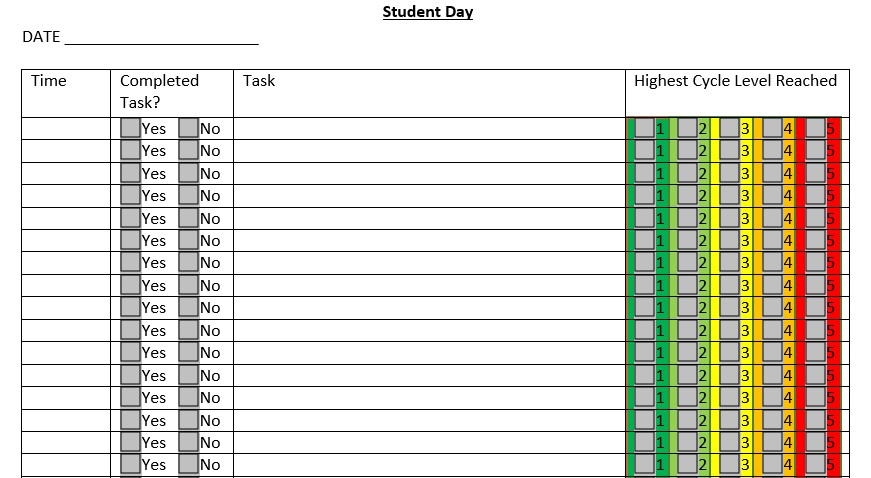Differential Reinforcement of Low Rates of behavior (DRL) is “a schedule of reinforcement in which reinforcement: (a) follows each occurrence of the target behavior that is separated from the previous response by a minimum interresponse time, or (b) is contingent on the number of responses within a period of time not exceeding a predetermined criterion” (Cooper, Heron & Heward, 2007).
There may be times when you want to greatly reduce a behavior, but don’t want to eliminate it altogether. Researchers have used DRL to decrease many behaviors, including: stereotypic responding (Singh, Dawson, & Manning, 1981), talking out in class (Dietz & Repp, 1973), and rate of taking bites while eating (Lennox, Miltenberger, and Donelly, 1987).
 There are a few different ways to implement DRL. You might select a target number of times the behavior can be exhibited within a full session, then deliver reinforcement to the individual if they exhibit the behavior that number of times or less within the session. For example, Gina teaches in a preschool where they have a 5-minute circle time each morning. During circle time, a boy named Luke raises his hand constantly. Gina wants to reduce the number of times he raises his hand during circle time, but she does not want to eliminate the behavior altogether. She took some baseline data and discovered that he raised his hand approximately 12 times during each circle time. Gina decided that Luke would be allowed to go to the water table, (his favorite activity,) if he raised his hand 10 times or less during circle time. This is called a criterion limit. As his behavior decreased, she would decrease the number of times he was able to raise his hand in order to access reinforcement. Her goal was to get him down to 3 instances of raising his hand during the circle time activity. This procedure for DRL is useful in a classroom setting, because it does not require the teacher to take a lot of data or keep track of intervals, though that might be appropriate in other situations.
There are a few different ways to implement DRL. You might select a target number of times the behavior can be exhibited within a full session, then deliver reinforcement to the individual if they exhibit the behavior that number of times or less within the session. For example, Gina teaches in a preschool where they have a 5-minute circle time each morning. During circle time, a boy named Luke raises his hand constantly. Gina wants to reduce the number of times he raises his hand during circle time, but she does not want to eliminate the behavior altogether. She took some baseline data and discovered that he raised his hand approximately 12 times during each circle time. Gina decided that Luke would be allowed to go to the water table, (his favorite activity,) if he raised his hand 10 times or less during circle time. This is called a criterion limit. As his behavior decreased, she would decrease the number of times he was able to raise his hand in order to access reinforcement. Her goal was to get him down to 3 instances of raising his hand during the circle time activity. This procedure for DRL is useful in a classroom setting, because it does not require the teacher to take a lot of data or keep track of intervals, though that might be appropriate in other situations.
Another possibility for implementing DRL is to use an interval schedule of reinforcement. As in the previous procedure, you would set a criterion limit (like Gina did with the limit of 10 instances of hand-raising). However, for this procedure, you would divide the session into intervals and set a criterion limit for each interval. If the number of times the behavior is emitted meets the criterion limit or is less than the criterion limit, then the individual receives reinforcement at the end of the interval. So, Gina could use an interval DRL for addressing Luke’s behavior. In this instance, she might divide the 5-minute circle time into 10 30-second intervals. (I would suggest wearing a VibraLite watch or an interval app such as the ABA Interval Recording App to track the intervals.) Gina decides that the criterion limit will start at 2 instances of hand-raising each interval. If Luke raises his hand 2 times or less in an interval, then at the end of the interval she gives him a little bit of individualized attention, such as a pat on the shoulder or verbal praise.
A third way to implement a DRL is called spaced-responding DRL. In this procedure, you will measure interresponse time (or IRT… behavior analysts love their abbreviations, don’t they?!). So, in Gina’s intervention with Luke, this means that she would measure the amount of time from one instance of hand-raising to the next instance of hand-raising, or “the duration of time between two responses” (Cooper, Heron, & Heward, 2007). The goal here would be to increase the amount of time between instance of hand-raising, which would mean that Luke was raising his hand less frequently. Gina discovers that Luke is raising his hand about once every 25 seconds. She will begin by providing social reinforcement when he has gone 30 seconds without raising his hand. Over time, she will systematically increase the IRT until Luke is raising his hand approximately once every 2 minutes during circle time.
When designing an intervention using DRL there are a few things you should consider:
- You do not want to use DRL with self-injurious or dangerous behaviors.
- DRl usually produces a slow change in the behavior, so if it necessary to quickly decrease the rate of a behavior, you should select a different form of differential reinforcement.
- There are several ways to implement DRL, and you should select the procedure that makes the most sense for the behavior you are addressing and the environment you are in.
- Plan ahead so you are systematically decreasing the number of responses the individual is engaging in.
- Be sure to take baseline data to determine your criterion limits! DRL will not be successful if you set them too low for your child or client to come into contact with reinforcement.
- Get help when implementing DRL. Talk to a BCBA about the best way to implement it for your learner.
REFERENCES
Cooper J.O, Heron T.E, Heward W.L. Applied behavior analysis (2nd ed.) Upper Saddle River, NJ: Pearson; 2007
Dietz, S. M., & Repp, A. C. (1973). Decreasing classroom misbehavior through the use of DRL schedules of reinforcement. Journal of Applied Behavior Analysis, 6(3), 457.
Lennox, D. B., Miltenberger, R. G., & Donnelly, D. R. (1987). Response interruption and DRL for the reduction of rapid eating. Journal of Applied Behavior Analysis, 20(3), 279-284.
Singh, N. N., Dawson, M. J., & Manning, P. (1981). Effects of spaced responding DRL on the stereotyped behavior of profoundly retarded persons. Journal of Applied Behavior Analysis, 14(4), 521-526.
WRITTEN BY SAM BLANCO, MSED, BCBA
Sam is an ABA provider for students ages 3-12 in NYC. Working in education for ten years with students with Autism Spectrum Disorders and other developmental delays, Sam has developed strategies for achieving a multitude of academic, behavior, and social goals. Sam is currently pursuing her PhD in Applied Behavior Analysis at Endicott College.
 Created by Linda C. Becht, Sensible Pencil is a step-by-step handwriting program developed for students with special needs. With 200 sequential worksheets, new writers will learn how to write quickly and efficiently. This week, you can save 15%* on Sensible Pencil with promo code PENCIL15 at check-out!
Created by Linda C. Becht, Sensible Pencil is a step-by-step handwriting program developed for students with special needs. With 200 sequential worksheets, new writers will learn how to write quickly and efficiently. This week, you can save 15%* on Sensible Pencil with promo code PENCIL15 at check-out!
 There are a few different ways to implement DRL. You might select a target number of times the behavior can be exhibited within a full session, then deliver reinforcement to the individual if they exhibit the behavior that number of times or less within the session. For example, Gina teaches in a preschool where they have a 5-minute circle time each morning. During circle time, a boy named Luke raises his hand constantly. Gina wants to reduce the number of times he raises his hand during circle time, but she does not want to eliminate the behavior altogether. She took some baseline data and discovered that he raised his hand approximately 12 times during each circle time. Gina decided that Luke would be allowed to go to the water table, (his favorite activity,) if he raised his hand 10 times or less during circle time. This is called a criterion limit. As his behavior decreased, she would decrease the number of times he was able to raise his hand in order to access reinforcement. Her goal was to get him down to 3 instances of raising his hand during the circle time activity. This procedure for DRL is useful in a classroom setting, because it does not require the teacher to take a lot of data or keep track of intervals, though that might be appropriate in other situations.
There are a few different ways to implement DRL. You might select a target number of times the behavior can be exhibited within a full session, then deliver reinforcement to the individual if they exhibit the behavior that number of times or less within the session. For example, Gina teaches in a preschool where they have a 5-minute circle time each morning. During circle time, a boy named Luke raises his hand constantly. Gina wants to reduce the number of times he raises his hand during circle time, but she does not want to eliminate the behavior altogether. She took some baseline data and discovered that he raised his hand approximately 12 times during each circle time. Gina decided that Luke would be allowed to go to the water table, (his favorite activity,) if he raised his hand 10 times or less during circle time. This is called a criterion limit. As his behavior decreased, she would decrease the number of times he was able to raise his hand in order to access reinforcement. Her goal was to get him down to 3 instances of raising his hand during the circle time activity. This procedure for DRL is useful in a classroom setting, because it does not require the teacher to take a lot of data or keep track of intervals, though that might be appropriate in other situations.




 DRI is not always the best option. For example, it may be very challenging to come up with an incompatible behavior. Or, in the case of self-injurious or aggressive behavior, it may be dangerous to use such an intervention.
DRI is not always the best option. For example, it may be very challenging to come up with an incompatible behavior. Or, in the case of self-injurious or aggressive behavior, it may be dangerous to use such an intervention. Daily planners are an effective way to help kids stay organized as they become more responsible and self-reliant. The
Daily planners are an effective way to help kids stay organized as they become more responsible and self-reliant. The  The
The 

 Who works here? Why might they be laughing? When do you eat at the table? Use this set of 36 Wh- Question ColorCards and unlock opportunities to discover, understand, and practice Wh-questions. This week only, take 15%* off your set of the
Who works here? Why might they be laughing? When do you eat at the table? Use this set of 36 Wh- Question ColorCards and unlock opportunities to discover, understand, and practice Wh-questions. This week only, take 15%* off your set of the  The ColorCards feature vivid photos of scenarios that allow for multiple opportunities to develop this key skill. These cards can be used in group or one-to-one settings, and come with a booklet with sample Wh- questions to ask for each of the images depicted.
The ColorCards feature vivid photos of scenarios that allow for multiple opportunities to develop this key skill. These cards can be used in group or one-to-one settings, and come with a booklet with sample Wh- questions to ask for each of the images depicted.